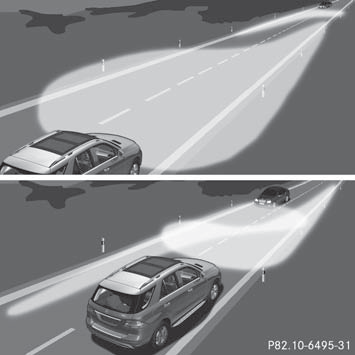Adaptive Highbeam Assist
You can use this function to set the headlamps to change between low beam and high beam automatically. The system recognizes vehicles with their lights on, either approaching from the opposite direction or traveling in front of your vehicle, and consequently switches the headlamps from high beam to low beam.
The system automatically adapts the lowbeam headlamp range depending on the distance to the other vehicle. Once the system no longer detects any other vehicles, it reactivates the high-beam headlamps.
The system's optical sensor is located behind the windshield near the overhead control panel.

- To activate: activate the Adaptive
Highbeam Assist function using the onboard
computer.
- Turn the light switch to  or
or
 .
.
- Press the combination switch beyond the
pressure point in the direction of arrow 1.
If it is dark and the light sensor activates
the low-beam headlamps, the  indicator lamp in the instrument cluster
lights up.
indicator lamp in the instrument cluster
lights up.
If you drive faster than approximately
28 mph (45 km/h):
the headlamp range is set automatically
depending on the distance between the
vehicle and other road users.
If you drive faster than approximately
35 mph (55 km/h) and no other road users
are identified:
the high-beam headlamps are switched on
automatically. The  indicator lamp
in
the instrument cluster also lights up.
indicator lamp
in
the instrument cluster also lights up.
When you drive slower than approximately
30 mph (45 km/h) or if other road users
are identified or if the roads are sufficiently
illuminated:
the high-beam headlamps are switched off
automatically. The  indicator lamp
in
the instrument cluster goes out. The
indicator lamp
in
the instrument cluster goes out. The  indicator lamp in the instrument cluster
stays on.
indicator lamp in the instrument cluster
stays on.
- To deactivate: move the combination
switch back to its normal position.
The  indicator lamp in the
instrument
cluster goes out.
indicator lamp in the
instrument
cluster goes out.
 WARNING
WARNING
The Adaptive Highbeam Assist is only an aid
intended to support you while driving. The
driver is and remains responsible for proper
vehicle lighting in accordance with the
prevailing light, sight and traffic conditions.
The system may be impaired or unavailable
when
- visibility is poor, e.g. due to snow, rain, fog,
or heavy spray
- the optical sensor area of the windshield is
dirty, fogged up, or covered by a sticker for
example
The system cannot recognize the following
road users:
- Road users without a lighting system of
their own, e.g. pedestrians
- Road users with dim lighting of their own,
e.g. cyclists
- Road users whose lighting is obstructed,
e.g. road users behind a guardrail
- In some seldom cases, even road users with
a lighting system of their own may be
recognized too late or not at all.
The automatic high-beam headlamps will then
not be deactivated or it will be activated in
spite of preceding or oncoming road users.
This could endanger you and/or others and
cause an accident. Always pay close attention
to the traffic situation and switch off the high
beam manually if necessary.
See also:
Overview of interior lighting
Overhead control panel
1 To switch the left-hand front
reading
lamp on/off
2 To switch the front interior
lighting
on
3 To switch the rear interior
lighting
on/off
4 To switch th ...
Search & Send
"Search & Send" is a destination entry
service. You can find further information on
"Search & Send" in the separate COMAND
operating instructions. ...
Downhill gradients
On long and steep gradients, you must
reduce the load on the brakes by shifting
early to a lower gear. This allows you to take
advantage of the engine braking effect and
helps avoid overheati ...
